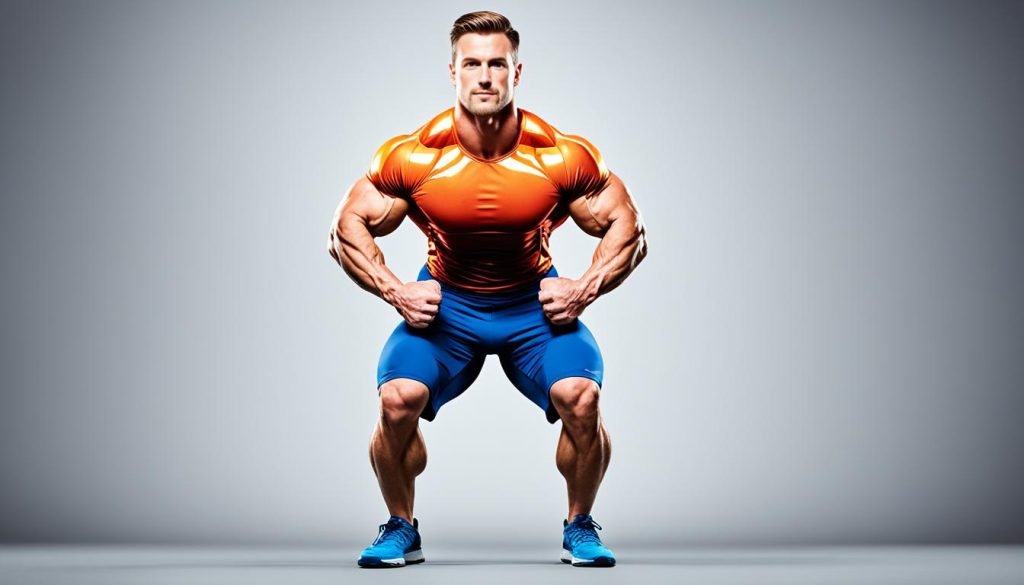Ever thought if the weight you're lifting for goblet squats is really helping you get stronger? Finding the right weight for goblet squats is key for everyone, from newbies to top athletes. This exercise boosts muscle strength and improves overall fitness. By picking the right weight, you make sure you're getting the most out of goblet squats.
Beginners usually start with about 30 lb. But experienced lifters can lift much more, up to 192 lb. Knowing these numbers helps you see how much you're improving.
Key Takeaways
- Goblet squat weight is essential for maximizing strength gains.
- It is important to find an optimal load based on individual fitness levels.
- Beginners typically start with around 30 lb.
- Elite lifters may manage weights upwards of 192 lb.
- Understanding these weight classifications can enhance muscle engagement.
Introduction to Goblet Squats
Goblet squats are a key exercise in strength training. They make the basic squat movement easier by keeping a weight close to the chest. This helps with keeping the body in the right position. Adding a kettlebell or dumbbell makes the goblet squat form easier for people at all fitness levels.
This exercise focuses on the right goblet squat technique. It works out muscles like the quadriceps, hamstrings, and glutes. Goblet squats help keep the torso in the right position. When done right, they help avoid problems seen in other squats, like not going deep enough or having a rounded back. With the right advice, beginners can easily learn this exercise. It's great for building strength and stability.
Understanding Goblet Squat Weight
Finding the right goblet squat weights is key for lifters at every level. The weights change a lot based on the lifter's skill and strength. This part will look at the usual weights for beginners to top-level lifters. It will also cover what affects how well you can squat.
Standard Goblet Squat Weights for Beginners to Elite Lifters
The table below shows the typical goblet squat weights for different levels. These weights help check a lifter's strength and where they are in their strength journey:
| Category | Average Weight (lbs) |
|---|---|
| Beginner | 30 |
| Novice | 56 |
| Intermediate | 93 |
| Advanced | 140 |
| Elite | 192 |
Factors Affecting Goblet Squat Weight
Many things affect how well you can squat with goblet weights. Important factors include:
- Body Weight: Bigger lifters can handle more weight, while lighter ones need less.
- Lifting Experience: Those with more experience can lift heavier weights faster.
- Age: Young people usually have more strength, which affects how much they can lift.
- Training Frequency: Training often helps muscles get better, letting you lift more.
- Muscle Recovery: Getting enough rest is key for doing well in future workouts.
- Proper Technique: Doing the goblet squat right is safe and helps you lift better.

Goblet Squat Form and Technique
Mastering the goblet squat technique is key for effective strength training. This guide offers steps for proper squatting and points out common mistakes. These mistakes can affect your performance and increase injury risk.
Steps for Proper Goblet Squat Execution
- Start by holding a dumbbell or kettlebell close to your chest, with both hands under the weight for support.
- Stand with your feet shoulder-width apart, toes slightly angled outward.
- As you start the squat, engage your core and keep your back straight, maintaining an upright torso.
- Push your knees outward while lowering your body, ensuring they stay in line with your toes throughout the movement.
- Descend until your thighs are parallel to the ground or as deep as your flexibility allows, controlling your descent.
- Push through your heels to return to the starting position, fully extending your hips and knees at the top.
Avoiding Common Goblet Squat Mistakes
- Resting elbows on thighs: This can restrict your range of motion and place unnecessary strain on your joints.
- Insufficient core engagement: A weak core compromises stability and balance, leading to improper squat execution.
- Allowing the back to round: Maintain a neutral spine to avoid strain and injury during the squat.
- Forgetting to breathe: Proper breathing is crucial. Inhale as you go down and exhale while pushing up.
| Mistake | Impact | Solution |
|---|---|---|
| Resting elbows on thighs | Limits movement | Keep elbows in close to the body |
| Insufficient core engagement | Instability | Focus on tightening the core throughout |
| Rounding the back | Risk of injury | Keep a neutral spine |
| Improper breathing | Reduced effectiveness | Practice consistent breathing patterns |
Benefits of Incorporating the Goblet Squat
The goblet squat is a great exercise with many benefits for your workout. It helps build lower body strength well. It works on muscles like the glutes, hamstrings, and quadriceps, making them stronger and more durable.
This exercise is a compound one, meaning it works many muscles at once. It's great for building strength and size efficiently.
Strength Development in Lower Body Muscles
Adding goblet squats to your routine boosts lower body strength and functional fitness. It lets you move naturally, which is good for your joints and gives you more motion than regular squats. Over time, your legs get stronger and more shaped, helping you do better in other exercises and sports.
Core Engagement and Stability
Goblet squats also focus on core stability. Since you hold a weight in front, your core must stay tight to balance and stay stable. This lowers injury risk and boosts your performance in strength training.
Working your legs and core together makes your midsection stronger. This improves your balance and mobility for other physical activities.
FAQ
What is the recommended goblet squat weight for beginners?
Beginners should start with about 30 lb. This helps build a solid foundation in squatting correctly.
How do I ensure proper goblet squat form?
Keep your torso straight and push your knees out. Control how far you go down, making sure your weight is over your heels.
What muscle groups are primarily worked during goblet squats?
Goblet squats work on quadriceps, hamstrings, glutes, and the core. It's a full-body exercise for the lower body.
How do goblet squats compare to back squats?
Goblet squats use a front-loaded weight, which helps with better form and core strength. Back squats focus more on the spine and lower back, which might increase injury risk.
How does weight progression work for goblet squats?
Weight increases depend on your fitness level. Intermediate lifters might aim for 93 lb, while top performers could lift up to 192 lb.
What are some effective goblet squat variations?
Good variations include using kettlebells, doing single-arm squats, and pausing at the squat's bottom. These help improve strength and stability.
What are common mistakes to avoid when performing goblet squats?
Avoid resting your elbows on your thighs, not using your core, and rounding your back. These mistakes can hurt your form and cause injuries.
Source Links
- Goblet Squat Standards for Men and Women (lb) – Strength Level – https://strengthlevel.com/strength-standards/goblet-squat/lb
- Goblet Squat Progression: From Beginner to Advanced – https://programme.app/resources/goblet-squat-progression:-from-beginner-to-advanced
- Learn How to Do a Goblet Squat from the Man Who Invented the Move – https://www.menshealth.com/fitness/a19536462/right-way-to-do-goblet-squat/
Recent Posts
It's important to evaluate whether Beachbody On Demand continues to meet your fitness needs as we enter 2025. With a range of workout programs and nutrition plans, the platform claims to cater to...
Just like having a personal trainer at your fingertips, Beachbody On Demand offers you an extensive library of on-demand workout programs accessible anytime, anywhere. This service allows you to...

